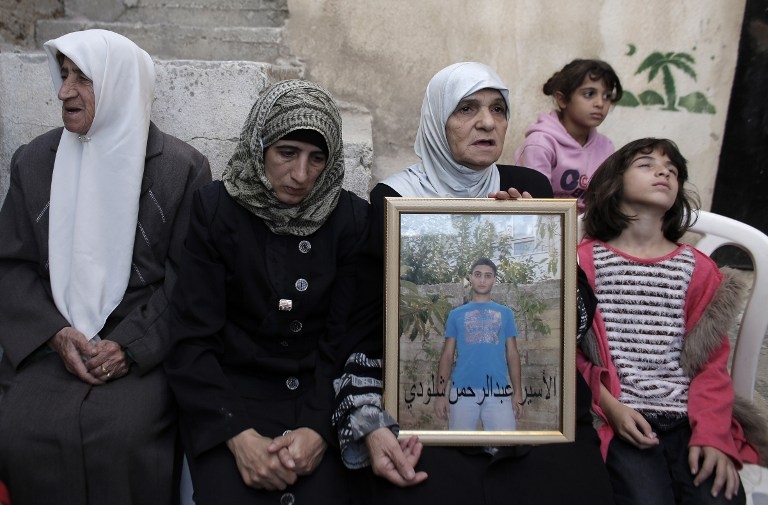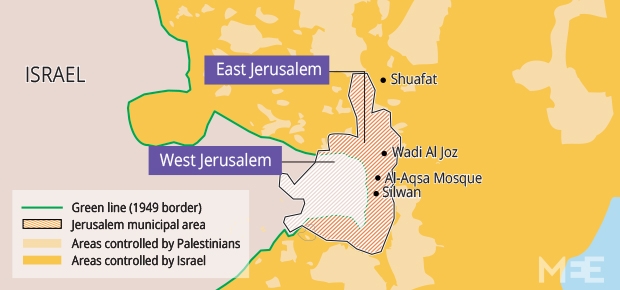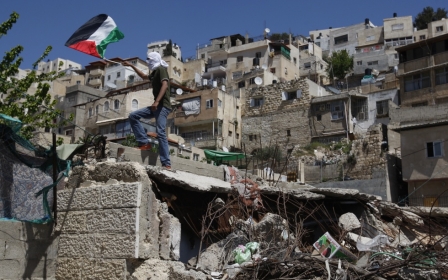After fatal Jerusalem crash, Palestinians reflect on growing hopelessness

JERUSALEM – It's been three days since Abd al-Rahman al-Shaludi crashed his car into a Jerusalem tram stop, injuring nine people and killing 3-month-old Haya Zissel-Braun. In what was quickly branded a terrorist attack by the Israeli authorities and public, he drove his vehicle at full speed into a crowd of people, fleeing from the scene on foot before being shot by police, dying from his injuries in hospital a few hours later.
Among many Israelis, the response to the attack has been one of loss and revulsion. Leaders of all political stripes were quick to demand uncompromising measures to curb the violence. In al-Shaludi's home neighbourhood of Silwan, the mood, too, was grim. The 21-year-old's family, who insist that the crash was an accident, have yet to receive his body. After spending more than a year in prison for stone-throwing and later arrested on suspicions of Hamas affiliation, they say, al-Shaludi had been struggling to cope, and had been referred to a therapist on Wednesday.
“The boy was in a very bad psychological situation because of being arrested and spending so many months in jail,” Jawad Siam, the director of Silwan’s Wadi Hilweh information Centre, told Middle East Eye. “The Israeli media are saying this young man is guilty and labelling him a terrorist, but they’re forgetting that there’s occupation. If there’s no occupation, this wouldn’t have happened, and because of the occupation he is dead, too.”
At al-Shaludi's funeral tent on Saturday, the occupation’s hold on Silwan is evident. Just a few hundred metres away from the al-Aqsa mosque compound, its unkempt buildings trip over each other down Jerusalem's steep hills, the roads potholed and the rubbish skips overflowing. There have been clashes nearly every night here for months now, where stones, fireworks and burning tyres are met with Israeli rubber bullets and tear gas. It’s normal for Israeli soldiers to be stationed on every corner and, in the relative quiet of Friday afternoon, kids that ventured too close to the soldiers' positions were met with rubber bullets and sound bombs.
“They are treating us like third world. Take a look at the roads, look around you. But if you go up five minutes from here, just five minutes, you will see the difference. Very different, it’s a dream,” Abed al-Shaludi, Abd al-Rahman’s cousin, says. “I call this place the background of Afghanistan. We wake up in the morning and there’s another idea, another destructive idea that they want to do. We have this year at least 800 people arrested. And many children too – one of the kids was eight years old.”
Much of the pressure Abed al-Shaludi describes in Silwan today is related to settlement enclaves: buildings scattered across the neighbourhood that are occupied by Jewish Israelis. These religious settlers regard Silwan as a crucial strategic and spiritual site, and over the course of some 20 years they’ve been seeking to establish Jewish dominance here, provoking anger and fear among Palestinians. This month began with an unprecedented expansion with Israelis doubling their number by moving into around 20 apartments. Right-wing leaders claimed, inaccurately, that there was now a Jewish majority in Silwan. Palestinians say the settlers, who live in new houses under the protection of armed soldiers and police, threaten their freedom and security daily.
“There’s more and more violence, when there’s already violence enough,” Siam says. “Both the soldiers and the settlers are violent, especially these kind of settlers. They aren’t families. They see Silwan as their own, as something that belongs to them. But we’ll never say, okay, you can have it.
“There are clashes here every night now. The police close the neighbourhood – they close the road so you can’t enter the village. It’s making people feel angry and depressed.”
The frustration and resentment felt by the population of Silwan is only heightened by the neighbourhood’s location. Siam’s home is at the centre of Jerusalem’s sacred geography, just a few hundred metres from the walls of the old city and the holy sites of al-Aqsa Mosque and the Western Wall. In recent weeks and months, the situation here has reached crisis point. Right-wing Israelis and military escorts regularly visit the mosque’s compound to pray, highlight Jewish significance, and assert sovereignty over what they call Temple Mount. Every time they’re met with resistance from Palestinian worshippers who believe they are threatening Muslim rights over the site. Restrictions on Muslim entry to the sacred space and tough crackdowns only intensifies the unrest.
“As long as there is aggression in al-Aqsa, there will not be quiet,” Siam says. The sacred space of the Old City may seem a world apart from the neglected streets of Silwan, but he believes the fate of the two are bound. “It’s become not just a religious symbol but a national symbol. Forget about all the aggression happening: Al-Aqsa is enough reason for the Palestinians to fight against the Israeli state.”
‘A people entirely adrift’
When al-Shaludi drove into the tram stop on Wednesday, the contested sites of Silwan and al-Aqsa – locations that have been at the focus of media attention – were both at boiling point. But so were neighbourhoods all over the city – areas like Wadi Joz, Ras al-Amud and Issawiya, where Arab populations have for decades felt marginalised and increasingly despairing about the future.
Attorney and activist Daniel Seidemann has worked in these neighbourhoods for decades, and as well as being among the most respected experts on Jerusalem, he’s represented Silwan families whose homes have been threatened by settler takeover. What’s going on in these neighbourhoods, he believes, is really quite simple. “Almost 50 percent of the detainees in East Jerusalem are 9, 12, 14, 15 years old,” he said, speaking to MEE the morning after the fatal crash. “What leaves hundreds, even thousands of kids to meet police forces in the streets on a nightly basis? It’s certainly not their parents sending them. I think what these kids see themselves as, as Palestinians in East Jerusalem, is as people entirely adrift. This doesn’t have to be something that comes from philosophy books, but a sense that life sucks particularly here, particularly for us.
"But in all of this, the response from the Israelis has been: we will crush you, we will break you, we will send more and more police. There has been no-one actually trying to speak to the Palestinians."
Seidemann believes what happened on Wednesday night was “spontaneous combustion” rather than organised terrorism as a number of Israeli politicians, like Likud's Danny Danon and Shas' Eli Yishai, have claimed in recent days. “The police have been successful in containing all the violence that’s happening in Palestinian neighbourhoods to the extent that until now most Israelis living in East Jerusalem could easily have been oblivious to what’s going on,” he explains. “I think part of the motivation behind this man’s actions was breaking through this barrier between the communities, and actually affecting those Israelis that have been protected from it.”
Jerusalem Light Rail, where the incident took place, is indeed a spot where Israeli and Palestinian lives intersect. The tram line serves Israeli settlements in east Jerusalem and cuts through several Arab neighbourhoods on its way to the west of the city. Although it’s accessible to everyone, many Palestinians view it as a tool of colonisation that deepens Israel’s grip on Jerusalem. Earlier this year, another stop on the line, in Shuafat, was also destroyed. It was from this neighbourhood to the north of the Old City that in July 16-year-old Mohammed Abu Khdeir was kidnapped by Jewish Israeli extremists and murdered in apparent revenge for the killing of three settler teenagers. After the killing Shuafat exploded and tramlines were torn up in violent protests.
In a city that’s long been simmering with desperation, fear and resentment these incidents are just the most high-profile of innumerable ruptures and manifestations of violence that have seen death, injury and destruction on a consistent but largely unnoticed scale. In each neighbourhood, the pressures on Jerusalem are making themselves felt in localised and particular ways. But among Palestinians the sense of hopelessness and abandonment is a common theme – one that only appears to be growing stronger.
“We’ve had a mini intifada now for three years now,” Abed al-Shaludi says. “I was in jail for ten years of my life during the first intifada. I’ve seen everything. I’ve been in jail, I’ve been beaten, I’ve been shot three or four times. I was wanted for two years. I don’t think there’s anything that can make me afraid now. And there’s a lot of other people like me.
“Just yesterday me and my friends were looking at the young boys running at the soldiers and saying to each other – it’s been almost 15 years now and it’s the same situation. Until when will this be going on? You can’t see anything good at the end of the tunnel. There should be signs along the way. But all the signs are bad.”
New MEE newsletter: Jerusalem Dispatch
Sign up to get the latest insights and analysis on Israel-Palestine, alongside Turkey Unpacked and other MEE newsletters
Middle East Eye delivers independent and unrivalled coverage and analysis of the Middle East, North Africa and beyond. To learn more about republishing this content and the associated fees, please fill out this form. More about MEE can be found here.





